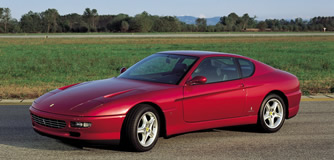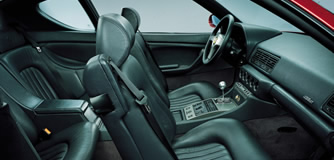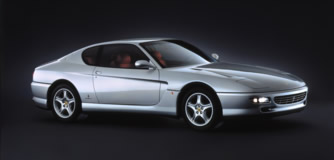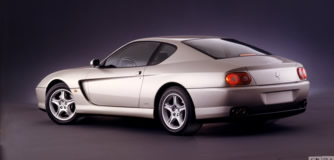|
Cockpit ergonomics meant passengers enjoyed high levels of comfort: the 456 GT set the standard for its class.
After a three year period without a V12 engine 2+2 model in the range, the 456 GT was
announced on the occasion of Ferrari's then Belgian concessionaire's fortieth anniversary in September 1992, making its public show debut in Paris the following month. As part of the Garage Francorchamps anniversary
celebrations, the new model was launched at a gala dinner in the Palais de Cinquantenaire in the centre of Brussels. This was a positive and brave move by the company, as the classic, luxury, and prestige sports car markets
were in deep recession, after all the speculation and hype of the late eighties. However, they showed their commitment to broadening their range, and to maintaining their position at the head of the list of the world's most
desirable automobiles.
The smooth rounded lines from the pen of Pininfarina drew praise from all sides, particularly the modernised reflection of the fabled 365 GTB/4 "Daytona" with the long bonnet, featuring
retractable headlight pods, running into a set back cabin. Also inspired by the "Daytona" was the design treatment of the rear of the cabin envelope and tail. Thus although the shape was thoroughly modern, it
contained retro trace elements to associate it with the company's history. One aerodynamic element that was almost imperceptible was the electronically activated spoiler below and within a cut-out in the rear valance, whose
angle changed relative to road speed to increase downforce. As with all the other models in the range at the time, it was designed as a world market car from the outset, and perhaps most importantly there was an USA market
model. However, where the preceding 2+2 models had been offered with automatic transmission, the 456 GT was initially only available with a manual gearbox. Here there was another analogy with the "Daytona", as it had
the gearbox mounted in unit with the differential and final drive assembly, forming a transaxle.
The bodies were mounted on a 2600mm wheelbase chassis, which was 100mm less than the 412 2+2 model, with a front track of
1585mm and rear track of 1606mm. It was constructed in the traditional steel tube fashion, incorporating substructures to support mechanical and body components, bearing factory type reference F 116 CL. All were numbered in the
continuous chassis number road car sequence in the range 96157 to 111376, and the production period spanned 1992 to 1998, during which time 1548 examples were produced. The model was available in right or left hand drive form,
with power assisted steering as standard. The majority of the body panels were aluminium, welded to the steel frame via a specially formulated sandwich material called Feran, which was chemically treated to permit the welding
of the two dissimilar metals, whilst the front and rear valances were composite mouldings.
The standard road wheels were stylised renditions of the traditional five spoke "star" alloy design, featuring elegant
convex spokes and five bolt fixing. Independent suspension was provided all round, with front and rear anti roll bars, and electronically operated driver controlled variable shock absorber settings, plus hydraulic self
levelling rear suspension. The adjustable dampers were provided with an electronic "brain" that monitored various factors, like steering angle, road speed and acceleration, to optimise the settings for the driving
conditions. The steering was power assisted, the degree of assistance varying with road speed, being greatest at parking speeds and diminishing with an increase in velocity. Four wheel ventilated disc brakes were provided, and
equipped with an ATE Mark IV Antiskid system, to minimise loss of traction under extreme conditions.
The engine was completely new, the first brand new 12 cylinder unit since the flat twelve "Boxer" unit some
two decades earlier, with factory type reference 116 B, and then 116 C. It also marked a return to the old tradition of the model designation number (456), relating to the approximate swept volume of a single cylinder in cubic
centimetres. Previous production V12 engines had a 60 degree angle between the cylinder banks, unless you think of the flat twelve "Boxer" engine as an 180 degree V12, whereas the new motor had an angle of 65 degrees.
The total cubic capacity was 5474cc, with a bore and stroke of 88mm x 75mm, four valves per cylinder, twin overhead camshafts per bank, and dry sump lubrication. The block, cylinder heads, sump, and sundry castings were
constructed from light alloy, featuring Nicasil treated alloy cylinder liners. A Bosch Motronic 2.7 combined fuel injection/ignition engine management system was fitted initially fitted, superseded by a Motronic 5.2 unit in
1996,
|



